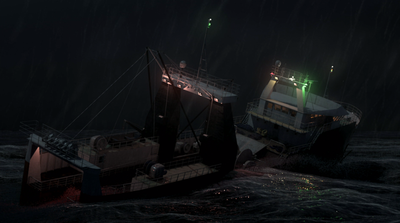Alaska Ranger: “Shipwrecked in Alaska”
On the night of March 23, 2008, most of the crew sleeps while fishing vessel Alaska Ranger makes her way to the rich fishing grounds off the coast of Alaska. As the Engineer makes his nightly rounds, he discovers a serious flood in the rudder room. He raises the alarm and the captain issues a Mayday call. But before the crew can investigate the source of the leak, the rising water reaches their electrical systems and the ship loses power. With the ship listing and in danger of sinking, the captain orders the crew to abandon ship. But when they launch the life rafts, they seem to shoot forward instead of staying beside the boat, making it nearly impossible to get on board. More than half the crew ends up floating in the frigid waters of the Bering Sea.
US Coast Guard rescuers race to get to the Alaska Ranger, but it’s in such a remote location that by the time they reach them the survivors are spread out over a wide area of ocean - making the rescue that much more complicated. Helicopters, a USCG cutter, and Good Samaritan ships all take part in the massive rescue effort, which will become the largest cold water rescue in US Coast Guard history. After hours of effort, forty-two of the forty-seven-man crew are saved. Five others have perished, including the Captain.
The US Coast Guard immediately launches a Marine Board of Investigation to determine what went wrong and why. It’s clear there was a breach in the hull that flooded the engine room, but there are many other questions. What caused the breach? And why did the life boats drift away from the ship so quickly?
“Shipwrecked in Alaska” aired at 10 p.m. ET on Tuesday, April 23, on Discovery Canada. Watch the trailer here:
Facts about the Alaska Ranger:
- The Alaska Ranger is a 190-foot floating fish factory, equipped with its own fish processing plant
- The ship is capable of hauling as much as 150 tons of fish in a single drag, heavier than a herd of 200 cows
- A funnel-shaped trawl net is dragged along the ocean floor for up to a dozen miles. Its mouth is held open by metal doors the size of refrigerators, and rollers on the underside prevent the net from getting stuck on rocks and coral
- Several hours later the net is pulled up and unzipped, spilling the fish out on the deck where they’re shoveled through a hatch into an eighty-ton holding tank
- The fish are sorted, headed, gutted and stacked in giant freezers
- The floating fish processing plant operated out of Dutch Harbor, the busiest fishing port in the United States
- More than 600 million pounds of fish are caught in Dutch Harbor each year, that’s a haul 20 times heavier than New York City’s Brooklyn Bridge- with a price tag of almost 200 million dollars
- In 2001, a fisherman in Alaska was 16 times more likely to die on the job than a police officer
- 112 out of 100, 000 fishermen perished on the job in 2008 alone.
- From 1992-2004, fishing deaths made up one third of all occupational fatalities in Alaska
- Wave heights in the Bering sea exceed 40 feet, taller than a three-story building, and temperatures drop as low as -45 degrees Celsius, making the Bering Sea one of the most difficult bodies of water to navigate
Behind the scenes: director’s cut
“The pain is too much, everything’s too much, I’m just going to open my suit and let the water rush in and take me down”. Watch Disasters at Sea director PJ Naworynski discuss inside stories about filming “Deadly Neglect”, the stories and characters who stand out to him, and some of the best moments that almost didn’t make the cut.
DISASTERS AT SEA is an original new docuseries airing on Tuesdays at 10 p.m. EST on Discovery Canada (US viewers can check out Smithsonian Channel). Each episode of DISASTERS AT SEA tells the unimaginable true story of a maritime disaster, combining harrowing re-enactments with expert analysis from marine investigators. Whether it’s survivor testimony about a sudden sound, GPS data about the ship’s speed, or the scatter pattern of wreckage at the bottom of the ocean, each piece of evidence helps investigators build a dramatic picture of the deadly chain of events















